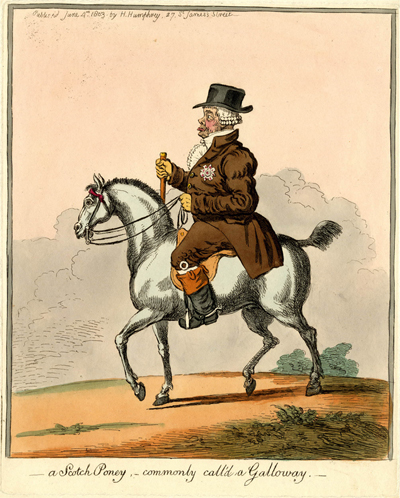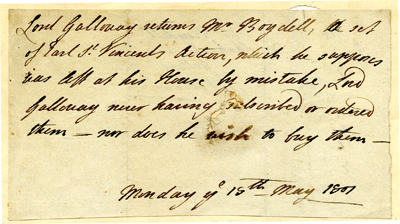A Scotch Poney, Commonly Call'd a Galloway
This beautifully executed print follows the traditional formula for portrait caricature in most ways: a full length portrait in profile, the identity hinted at but not explicitly named in the title, with a minimal, or barely sketched in, background. But partly for variety and partly for identification reasons, Gillray sets his subject upon a specific breed of Scottish poney which was then known as a Galloway thereby providing the clue to this horseman's identity.

© Trustees of the British Museum
By the time A Scotch Poney. . . appeared in 1803, John Stewart, 7th Earl of Galloway was enjoying the fruits of long (and legislatively invisible) career. He had been an M.P. for Morpeth (1761-1768) and then Ludgershall (1768-1773), before becoming a Scottish Peer after the death of his father, Alexander Stewart. From 1774 he was an elected peer to the British House of Lords remaining there until the 1790s. And from 1783 until his death he had a lovely sinecure as Lord of the Bedchamber to King George III. We know that he was a dedicated opera fan who had a box seat at the King's Theatre in 1789. (See my commentary on An Old Encore at the Opera which had been published a few months before this one.) And if you search for mentions of Galloway in 1803, you find him and his wife attending the King's 65th birthday, the Installation Ball, and among the list of "distinguished guests" at the routs and suppers of the rich and famous.
This entree to the courtier's world did not come without a price, however. He early earned the dislike of Robert Burns, who wrote:
No Stewart art thou, Galloway,
The Stewarts 'll were brave;
Besides, the Stewarts were but fools,
Not one of them a knave.
Bright ran thy line, O Galloway,
Thro' many a far-fam'd sire!
So ran the far-famed Roman way,
And ended in a mire.
Spare me thy vengeance, Galloway!
In quiet let me live:
I ask no kindness at thy hand,
For thou hast none to give.
And Edith Lady Haden-Guest in her writeup on Galloway for The History of Parliament describes Galloway as:
An ambitious self-seeking opportunist, almost fanatical in his zeal to exalt his family interest [who was] hated by his opponents, and distrusted even by his friends. He had few merits except a certain facile charm ('partly mechanical'), to offset his ill-temper, arrogance, insincerity, and avarice. His own heir [George, Lord Garlies] was ashamed of his father's reputation, his lack of 'consistency and dignity of character. . . .'
If his son was indeed ashamed of his father, that may help to explain an odd circumstance surrounding the British Museum copy of this print. On the reverse side, there is a handwritten note, dated Monday ye 15th May 1807,* presumably written by (or on hehalf of) the new heir since the 7th Lord Galloway had died in November 1806.

© Trustees of the British Museum
Lord Galloway returns Mr. Boydell the set of Earl St Vincents Action, which he supposes [he] has left at his house by mistake, Lord Galloway never having subscribed or ordered them—nor does he wish to buy them—
The reference is probably to two prints portaying Rodney's Victory over the Spanish off Cape St Vincent after Richard Paton published in 1780. But the question is why someone would use the back of what seems like a perfectly preserved print of the recently deceased Earl of Galloway to convey a message to Boydell. Did the new titleholder have such disdain for his father or for Gillray's portrayal of his father that he was, in effect, giving away the print? Were there multiple copies in the household, the print having served the vanity of the 7th Earl, and so this one was expendable? This is one of those cases where a time machine would be helpful.
* The note is misdated. The the 15th of May was not a Monday, but the 15th of June was. The month, in this case, appears to be in a slightly different ink, suggesting that it may have been added after the fact.
Sources and Reading
- Commentary from the British Museum on A Scotch Poney, Commonly Call'd a Galloway.
- "Galloway pony," Wikipedia
- "John Stewart, 7th Earl of Galloway," Wikipedia
- "John Stewart, Visct. Garlies," History of Parliament
- Thomas Wright and R.H. Evans, Historical and Descriptive Account of the Caricatures of James Gillray #461.
- Thomas Wright and Joseph Grego, The Works of James Gillray, the Caricaturist; With the History of His Life and Times, p. 307.
Comments & Corrections
NOTE: Comments and/or corrections are always appreciated. To make that easier, I have included a form below that you can use. I promise never to share any of the info provided without your express permission.